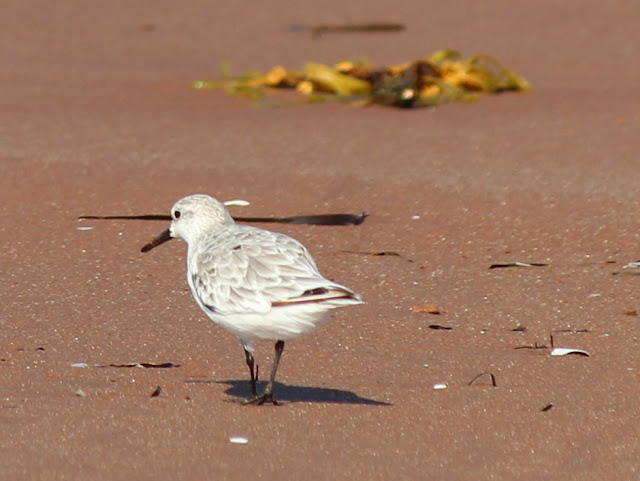As expected, there were a wide range of gull species spending time on the beach. I managed to get this picture of four different gull species together. From left to right, you can see a juvenile ring-billed gull, a herring gull, a juvenile great black-backed gull, and in the foreground, a Bonaparte's gull.
The ring-billed gull is easy to identify because of the black band around its beak. It is one of the most common birds in North America. It's the gull you might see in parking lots, scavenging dropped food items. The herring gull is the typical "seagull" that people talk about, and is also a very common bird along the shoreline.
The great black-backed gull is the largest gull in North America. It's often found with other gull species and is an aggressive bird which can benefit other birds that breed in the same area. The one in the picture above is a juvenile, not fully dark yet. Here's an adult with the full dark plumage.
My favourite of the gulls I saw was the diminutive Bonaparte's gull. It's not named after Napoleon - rather it is named after Charles Lucien Bonaparte, a member of the Academy of Natural Sciences in the US during the 1820s, who made significant contributions to ornithology. The gull is quite small and dainty in comparison to its larger brethren.
In breeding plumage, the head is entirely black and the legs are bright red. At this time of year, they are migrating and their plumage is just white with a characteristic grey spot on the side of the face. Their legs fade to a pink shade as well. Bonaparte's gulls actually nest in trees, unlike most other gull species.
There was a large group of common terns spending time on the beach with the gulls as well. The little terns make the Bonaparte's gulls look big!
Here's an adult common tern with a couple of juveniles who are still growing their adult plumage.
Naturally, the shore birds range from large to small, and there were a diversity of smaller birds as well. These included the unmistakable semipalmated plover, a much beloved shore bird in this part of the world. This one has a bit of a breeze blowing up her skirt.
They run up and down the sand looking for little crustaceans and other ocean dwelling treats. They often investigate little piles of seaweed, where I'm sure little creatures get caught, just waiting to be found by the plovers.
The semipalmated sandpiper was also common on the beach, also running so fast you can barely see their legs move.
This little group includes, I believe, a least sandpiper on the far left, which can be identified by its yellowish-green legs. The semi-palmated sandpipers have black legs. The other three may also be least sandpipers or semi-palmated.
This little bird is a sanderling. It breeds in the Canadian high arctic but migrates along the shoreline and winters along both coasts of North America. This one appears to be a juvenile based on the plumage.
The adult non-breeding plumage gets quite pale.
On the last day, I saw a new-to-me bird of prey, which I had some trouble photographing due to its swooping and diving behaviour. It is easy to identify the female Northern Harrier from its distinctive barred tail and the white flash at the point where the tail meets the body. My pictures aren't great because I was at some distance and the movement of the bird made it tough to focus, but the tail is clear.
Here you can see the underside of the Northern Harrier, along with the distinctive barring on the underside of the wings.
I'm not sure what she ended up catching, and I didn't really want to see.
It was a lovely vacation for birding!















3 comments:
Such good photos of so many varieties!
Amazing bird observations!
Oh, look at you knowing all those birds!! I'm impressed. I am a big bird-watcher at home, but I never really take a hard look at the birds when I am at the beach. I guess I am going to start now....they are really pretty!
Post a Comment